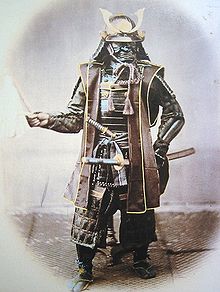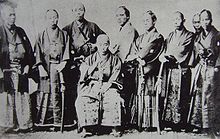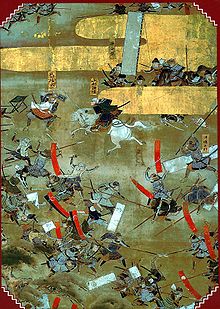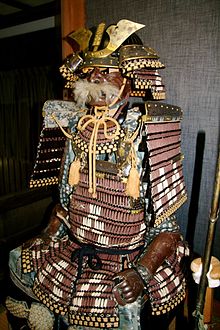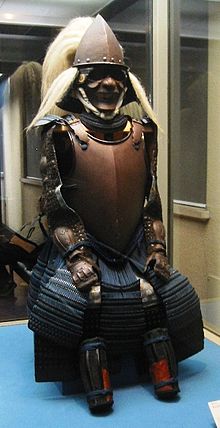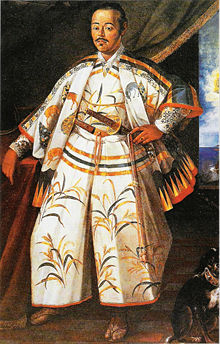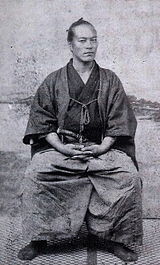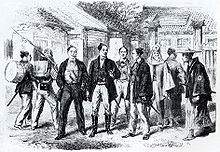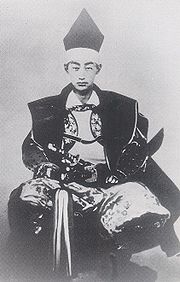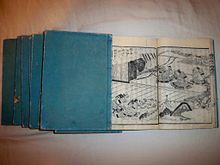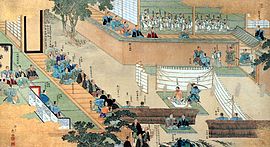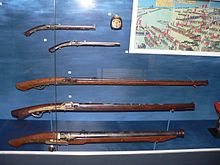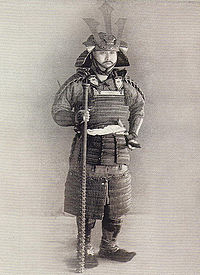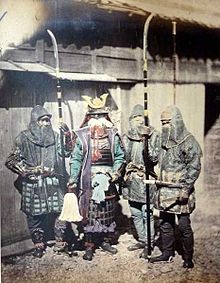- Samurai
-
 Saigo Takamori (upper right, in Western uniform) directing his troops, some of them in traditional samurai armor, at the Battle of Shiroyama.
Saigo Takamori (upper right, in Western uniform) directing his troops, some of them in traditional samurai armor, at the Battle of Shiroyama.
Samurai (侍) is the term for the military nobility of pre-industrial Japan. According to translator William Scott Wilson: "In Chinese, the character 侍 was originally a verb meaning to wait upon or accompany a person in the upper ranks of society, and this is also true of the original term in Japanese, saburau. In both countries the terms were nominalized to mean "those who serve in close attendance to the nobility," the pronunciation in Japanese changing to saburai. According to Wilson, an early reference to the word "samurai" appears in the Kokin Wakashū (905–914), the first imperial anthology of poems, completed in the first part of the 10th century.[1]
By the end of the 12th century, samurai became almost entirely synonymous with bushi (武士), and the word was closely associated with the middle and upper echelons of the warrior class. The samurai followed a set of rules that came to be known as bushidō. While they numbered less than 10% of Japan's population[2] samurai teachings can still be found today in both everyday life and in modern Japanese martial arts.
Contents
History
Following the Battle of Hakusukinoe against Tang China and Silla in 663 AD that led to a Japanese retreat from Korean affairs, Japan underwent widespread reform. One of the most important was that of the Taika Reform, issued by Prince Naka no Ōe (Emperor Tenji) in 646 AD. This edict allowed the Japanese aristocracy to adopt the Tang Dynasty political structure, bureaucracy, culture, religion, and philosophy.[3] As part of the Taihō Code, of 702 AD, and the later Yōrō Code,[4] the population was required to report regularly for census, which was used as a precursor for national conscription. With an understanding of how the population was distributed, Emperor Mommu introduced the law whereby 1 in 3–4 adult males was drafted into the national military. These soldiers were required to supply their own weapons, and in return were exempted from duties and taxes.[3] This was one of the first attempts by the Imperial government to form an organized army modeled after the Chinese system. It was called gundan-sei (軍団制) by later historians and is believed to have been short-lived.[citation needed]
The Taihō Code classified most of the imperial bureaucrats into 12 ranks, each divided into two sub-ranks, 1st rank being the highest adviser to the emperor. Those of 6th rank and below were referred to as "samurai" and dealt with day-to-day affairs. Although these "samurai" were civilian public servants, the name is believed[by whom?] to have derived from this term. Military men, however, would not be referred to as "samurai" for many more centuries.[citation needed]
In the early Heian period, the late 8th and early 9th centuries, Emperor Kammu sought to consolidate and expand his rule in northern Honshū, but the armies he sent to conquer the rebellious Emishi people lacked motivation and discipline, and failed in their task.[citation needed] Emperor Kammu introduced the title of Seiitaishogun (征夷大将軍) or shogun, and began to rely on the powerful regional clans to conquer the Emishi. Skilled in mounted combat and archery (kyūdō), these clan warriors became the emperor's preferred tool for putting down rebellions.[citation needed] Although this is the first time 'shogun' title is used, it was a temporal title and had not been accompanied with political power until 13th century, and at this time (7th to 9th century) the imperial court officials considered them to be merely military section under control of imperial court.
Ultimately, Emperor Kammu disbanded his army. From this time, the emperor's power gradually declined. While the emperor was still the ruler, powerful clans around Kyoto (京都) assumed positions as ministers, and their relatives bought positions as magistrates.[citation needed] To amass wealth and repay their debts, magistrates often imposed heavy taxes, resulting in many farmers becoming landless.[citation needed]
Through protective agreements and political marriages, they accumulated political power, eventually surpassing the traditional aristocracy.[citation needed]
Some clans were originally formed by farmers who had taken up arms to protect themselves from the imperial magistrates sent to govern their lands and collect taxes.[citation needed] These clans formed alliances to protect themselves against more powerful clans, and by the mid-Heian period they had adopted characteristic Japanese armor and weapons, and laid the foundations of Bushido, their ethical code.[citation needed]
After the Genpei war of the late 12th century, a clan leader Minamoto no Yoritomo obtained the right to appoint shugo and jito, and was allowed to organize soldiers and police, and to collect certain amount of tax. Initially, their responsibility was restricted to arresting rebels and collecting needed army provisions, and they were forbidden to interfere with kokushi governors, but their responsibility gradually expanded and thus the samurai-class appeared as the political ruling power in Japan. Minamoto no Yoritomo opened the Kamakura Bakufu shogunate in 1192.
Samurai warriors described themselves as followers of "The Way of the Warrior" or Bushido. Bushidō is defined by the Japanese dictionary Shogakukan Kokugo Daijiten as "a unique philosophy (ronri) that spread through the warrior class from the Muromachi (chusei) period. From the earliest times, the Samurai felt that the path of the warrior was one of honor, emphasizing duty to one's master, and loyalty unto death.[5]
In the 13th century, Hojo Shigetoki (1198–1261 AD) wrote: "When one is serving officially or in the master's court, he should not think of a hundred or a thousand people, but should consider only the importance of the master."[6]
In his 1979 Dissertation about the Hojo, Carl Steenstrup noted that 13th and 14th century warrior writings (gunki) "portrayed the bushi in their natural element, war, eulogizing such virtues as reckless bravery, fierce family pride, and selfless, at times senseless devotion of master and man."[7]
Feudal lords such as Shiba Yoshimasa (1350–1410 AD) stated that a warrior looked forward to a glorious death in the service of a military leader or the emperor: "It is a matter of regret to let the moment when one should die pass by....First, a man whose profession is the use of arms should think and then act upon not only his own fame, but also that of his descendants. He should not scandalize his name forever by holding his one and only life too dear....One's main purpose in throwing away his life is to do so either for the sake of the Emperor or in some great undertaking of a military general. It is that exactly that will be the great fame of one's descendants."[8]
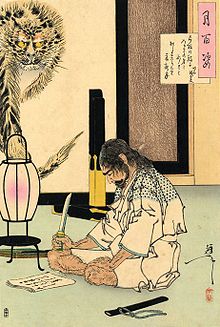 General Akashi Gidayu preparing to commit Seppuku after losing a battle for his master in 1582. He had just written his death poem.
General Akashi Gidayu preparing to commit Seppuku after losing a battle for his master in 1582. He had just written his death poem.
In 1412 AD, Imagawa Sadayo wrote a letter of admonishment to his brother stressing the importance of duty to one's master. Imagawa was admired for his balance of military and administrative skills during his lifetime and his writings became widespread. The letters became central to Tokugawa-era laws and were a required study for traditional Japanese until World War II[citation needed]:
"First of all, a samurai who dislikes battle and has not put his heart in the right place even though he has been born in the house of the warrior, should not be reckoned among one's retainers....It is forbidden to forget the great debt of kindness one owes to his master and ancestors and thereby make light of the virtues of loyalty and filial piety....It is forbidden that one should...attach little importance to his duties to his master...There is a primary need to distinguish loyalty from disloyalty and to establish rewards and punishments."[9]
Similarly. the feudal lord Takeda Nobushige (1525–1561 AD) stated: "In matters both great and small, one should not turn his back on his master's commands...One should not ask for gifts or enfiefments from the master...No matter how unreasonably the master may treat a man, he should not feel disgruntled...An underling does not pass judgments on a superior"[10]
Nobushige's brother Takeda Shingen (1521–1573 AD) also made similar observations: "One who was born in the house of a warrior, regardless of his rank or class, first acquaints himself with a man of military feats and achievements in loyalty....Everyone knows that if a man doesn't hold filial piety toward his own parents he would also neglect his duties toward his lord. Such a neglect means a disloyalty toward humanity. Therefore such a man doesn't deserve to be called 'samurai'."[11]
The feudal lord Asakura Yoshikage (1428–1481 AD) wrote: "In the fief of the Asakura, one should not determine hereditary chief retainers. A man should be assigned according to his ability and loyalty." Asakura also observed that the successes of his father were obtained by the kind treatment of the warriors and common people living in domain. By his civility, "all were willing to sacrifice their lives for him and become his allies."[12]
Kato Kiyomasa was one of the most powerful and well-known lords of the Sengoku Era. He commanded most of Japan's major clans during the invasion of Korea (1592–1598). In a handbook he addressed to "all samurai, regardless of rank" he told his followers that a warrior's only duty in life was to "grasp the long and the short swords and to die". He also ordered his followers to put forth great effort in studying the military classics, especially those related to loyalty and filial piety. He is best known for his quote:[13] "If a man does not investigate into the matter of Bushido daily, it will be difficult for him to die a brave and manly death. Thus it is essential to engrave this business of the warrior into one's mind well."
Nabeshima Naoshige (1538–1618 AD) was another Sengoku Daimyo who fought alongside Kato Kiyomasa in Korea. He stated that it was shameful for any man to have not risked his life at least once in the line of duty, regardless of his rank. Nabeshima's sayings would be passed down to his son and grandson and would become the basis for Tsunetomo Yamamoto's Hagakure. He is best known for his saying "The way of the Samurai is in desperateness. Ten men or more cannot kill such a man."[14][15]
Torii Mototada (1539–1600) was a feudal lord in the service of Tokugawa Ieyasu. On the eve of the battle of Sekigahara, he volunteered to remain behind in the doomed Fushimi Castle while his lord advanced to the east. Torii and Tokugawa both agreed that the castle was indefensible. In an act of loyalty to his lord, Torii chose to remain behind, pledging that he and his men would fight to the finish. As was custom, Torii vowed that he would not be taken alive. In a dramatic last stand, the garrison of 2,000 men held out against overwhelming odds for ten days against the massive army of Ishida Mitsunari's 40,000 warriors. In a moving last statement to his son Tadamasa, he wrote:[16]
"It is not the Way of the Warrior [i.e., bushido] to be shamed and avoid death even under circumstances that are not particularly important. It goes without saying that to sacrifice one's life for the sake of his master is an unchanging principle. That I should be able to go ahead of all the other warriors of this country and lay down my life for the sake of my master's benevolence is an honor to my family and has been my most fervent desire for many years."
It is said that both men cried when they parted ways, because they knew they would never see each other again. Torii's father and grandfather had served the Tokugawa before him and his own brother had already been killed in battle. Torii's actions changed the course of Japanese history. Ieyasu Tokugawa would successfully raise an army and win at Sekigahara.
The translator of Hagakure, William Scott Wilson observed examples of warrior emphasis on death in clans other than Yamamoto's: "he (Takeda Shingen) was a strict disciplinarian as a warrior, and there is an exemplary story in the Hagakure relating his execution of two brawlers, not because they had fought, but because they had not fought to the death."[17][18]
The rival of Takeda Shingen (1521–1573) was Uesugi Kenshin (1530–1578), a legendary Sengoku warlord well-versed in the Chinese military classics and who advocated the "way of the warrior as death". Japanese historian Daisetz Teitaro Suzuki describes Uesugi's beliefs as: "Those who are reluctant to give up their lives and embrace death are not true warriors.... Go to the battlefield firmly confident of victory, and you will come home with no wounds whatever. Engage in combat fully determined to die and you will be alive; wish to survive in the battle and you will surely meet death. When you leave the house determined not to see it again you will come home safely; when you have any thought of returning you will not return. You may not be in the wrong to think that the world is always subject to change, but the warrior must not entertain this way of thinking, for his fate is always determined."[19]
Families such as the Imagawa were influential in the development of warrior ethics and were widely quoted by other lords during their lifetime. The writings of Imagawa Sadayo were highly respected and sought out by Tokugawa Ieyasu as the source of Japanese Feudal Law. These writings were a required study among traditional Japanese until World War II[citation needed].
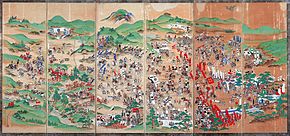 Edo period screen depicting the Battle of Sekigahara. It began on October 21, 1600 with a total of 160,000 men facing each other.
Edo period screen depicting the Battle of Sekigahara. It began on October 21, 1600 with a total of 160,000 men facing each other.
Historian H. Paul Varley notes the description of Japan given by Jesuit leader St. Francis Xavier (1506–1552): "There is no nation in the world which fears death less." Xavier further describes the honor and manners of the people: "I fancy that there are no people in the world more punctilious about their honour than the Japanese, for they will not put up with a single insult or even a word spoken in anger." Xavier spent the years 1549–1551 converting Japanese to Christianity. He also observed: "The Japanese are much braver and more warlike than the people of China, Korea, Ternate and all of the other nations around the Philippines."[20]
In December 1547, Francis was in Malacca (Malaysia) waiting to return to Goa (India) when he met a low-ranked samurai named Anjiro (possibly spelled "Yajiro"). Anjiro was not a nobleman or an intellectual, but he impressed Xavier because he took careful notes of everything he said in church. Xavier made the decision to go to Japan in part because this low-ranking samurai convinced him in Portuguese that the Japanese people were highly educated and eager to learn. They were hard workers and respectful of authority. In their laws and customs they were led by reason, and, should the Christian faith convince them of its truth, they would accept it en masse.[21]
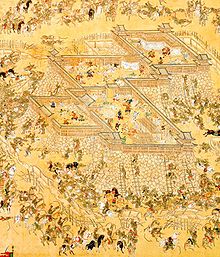 Korean and Chinese soldiers assault the Japanese-built fortress at Ulsan during the Japanese invasions of Korea, 1597
Korean and Chinese soldiers assault the Japanese-built fortress at Ulsan during the Japanese invasions of Korea, 1597
By the 12th century, upper-class samurai were highly literate due to the general introduction of Confucianism from China during the 7th to 9th centuries, and in response to their perceived need to deal with the imperial court, who had a monopoly on culture and literacy for most of the Heian period. As a result they aspired to the more cultured abilities of the nobility.[22]
Examples such as Taira Tadanori (a samurai who appears in the Heike Monogatari) demonstrate that warriors idealized the arts and aspired to become skilled in them.
Tadanori was famous for his skill with the pen and the sword or the "bun and the bu", the harmony of fighting and learning. Samurai were expected to be cultured and literate, and admired the ancient saying "Bun Bu Ryo Do" (文武両道, lit., literary arts, military arts, both ways) or "The pen and the sword in accord." By the time of the Edo period, Japan had a higher literacy comparable to that in central Europe.[23]
The number of men who actually achieved the ideal and lived their lives by it was high. An early term for warrior, "uruwashii", was written with a kanji that combined the characters for literary study ("bun" 文) and military arts ("bu" 武), and is mentioned in the Heike Monogatari (late 12th century). The Heike Monogatari makes reference to the educated poet-swordsman ideal in its mention of Taira no Tadanori's death:[24]
Friends and foes alike wet their sleeves with tears and said,
What a pity! Tadanori was a great general,
pre-eminent in the arts of both sword and poetry.In his book "Ideals of the Samurai" translator William Scott Wilson states: "The warriors in the Heike Monogatari served as models for the educated warriors of later generations, and the ideals depicted by them were not assumed to be beyond reach. Rather, these ideals were vigorously pursued in the upper echelons of warrior society and recommended as the proper form of the Japanese man of arms. With the Heike Monogatari, the image of the Japanese warrior in literature came to its full maturity."[24] Wilson then translates the writings of several warriors who mention the Heike Monogatari as an example for their men to follow.
Plenty of warrior writings document this ideal from the 13th century onward. Most warriors aspired to or followed this ideal otherwise there would have been no cohesion in the samurai armies.[25]
Kamakura Bakufu and the rise of samurai
Originally the emperor and nobility employed these warriors. In time, they amassed enough manpower, resources and political backing in the form of alliances with one another, to establish the first samurai-dominated government.
As the power of these regional clans grew, their chief was typically a distant relative of the emperor, and a lesser member of either the Fujiwara, Minamoto, or Taira clans.
Though originally sent to provincial areas for a fixed four-year term as a magistrate, the toryo declined to return to the capital when their terms ended, and their sons inherited their positions and continued to lead the clans in putting down rebellions throughout Japan during the middle- and later-Heian period.
Samurai fought at the naval battle of Dan-no-Ura in 1185. Because of their rising military and economic power, the warriors ultimately became a new force in the politics of the court. Their involvement in the Hōgen in the late Heian period consolidated their power, and finally pitted the rival Minamoto and Taira clans against each other in the Heiji Rebellion of 1160.
The winner, Taira no Kiyomori, became an imperial advisor, and was the first warrior to attain such a position. He eventually seized control of the central government, establishing the first samurai-dominated government and relegating the emperor to figurehead status.
However, the Taira clan was still very conservative when compared to its eventual successor, the Minamoto, and instead of expanding or strengthening its military might, the Taira clan had its women marry emperors and exercise control through the emperor.
The Taira and the Minamoto clashed again in 1180, beginning the Gempei War which ended in 1185. The victorious Minamoto no Yoritomo established the superiority of the samurai over the aristocracy. In 1190 he visited Kyoto, and in 1192 became Seii Taishogun, establishing the Kamakura Shogunate, or Kamakura Bakufu. Instead of ruling from Kyoto, he set up the Shogunate in Kamakura, near his base of power. "Bakufu" means "tent government", taken from the encampments the soldiers would live in, in accordance with the Bakufu's status as a military government.[26]
Over time, powerful samurai clans became warrior nobility, or "buke", who were only nominally under the court aristocracy. When the samurai began to adopt aristocratic pastimes like calligraphy, poetry and music, some court aristocrats in turn began to adopt samurai customs. In spite of various machinations and brief periods of rule by various emperors, real power was now in the hands of the Shogun and the samurai.
Ashikaga Shogunate
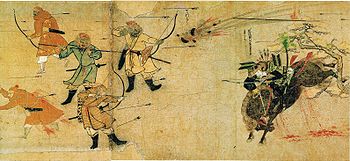 The Samurai Suenaga facing Mongols, during the Mongol invasions of Japan. Mōko Shūrai Ekotoba (蒙古襲来絵詞), circa 1293.
The Samurai Suenaga facing Mongols, during the Mongol invasions of Japan. Mōko Shūrai Ekotoba (蒙古襲来絵詞), circa 1293.
Various samurai clans struggled for power during the Kamakura and Ashikaga Shogunates.
Zen Buddhism spread among the samurai in the 13th century and helped to shape their standards of conduct, particularly overcoming fear of death and killing, but among the general populace, Pure Land Buddhism was favored.
In 1274, the Mongol-founded Yuan Dynasty in China sent a force of some 40,000 men and 900 ships to invade Japan in northern Kyūshū. Japan mustered a mere 10,000 samurai to meet this threat. The invading army was harassed by major thunderstorms throughout the invasion, which aided the defenders by inflicting heavy casualties. The Yuan army was eventually recalled and the invasion was called off. The Mongol invaders used small bombs, which was likely the first appearance of bombs and gunpowder in Japan.
The Japanese defenders recognized the possibility of a renewed invasion, and began construction of a great, stone barrier around Hakata Bay in 1276. Completed in 1277, this wall stretched for 20 kilometers around the border of the bay. This would later serve as a strong defensive point against the Mongols. The Mongols attempted to settle matters in a diplomatic way from 1275 to 1279, but every envoy sent to Japan was executed. This set the stage for one of the most famous engagements in Japanese history.
In 1281, a Yuan army of 140,000 men with 5,000 ships was mustered for another invasion of Japan. Northern Kyūshū was defended by a Japanese army of 40,000 men. The Mongol army was still on its ships preparing for the landing operation when a typhoon hit north Kyūshū island. The casualties and damage inflicted by the typhoon, followed by the Japanese defense of the Hakata Bay barrier, resulted in the Mongols again recalling their armies.
The thunderstorms of 1274 and the typhoon of 1281 helped the samurai defenders of Japan repel the Mongol invaders despite being vastly outnumbered. These winds became known as kami-no-kaze, which literally translates as "wind of the gods." This is often given a simplified translation as "divine wind." The kami-no-kaze lent credence to the Japanese belief that their lands were indeed divine and under supernatural protection.
In the 14th century, a blacksmith called Masamune developed a two-layer structure of soft and hard steel for use in swords. This structure gave much improved cutting power and endurance, and the production technique led to Japanese swords (katana) being recognized as some of the most potent hand weapons of pre-industrial East Asia. Many swords made using this technique were exported across the East China Sea, a few making their way as far as India.
Issues of inheritance caused family strife as primogeniture became common, in contrast to the division of succession designated by law before the 14th century. To avoid infighting, invasions of neighboring samurai territories became common and bickering among samurai was a constant problem for the Kamakura and Ashikaga Shogunates.
The Sengoku jidai ("warring-states period") was marked by the loosening of samurai culture with people born into other social strata sometimes making names for themselves as warriors and thus becoming de facto samurai. In this turbulent period, bushido ethics became important factors in controlling and maintaining public order.
Japanese war tactics and technologies improved rapidly in the 15th and 16th century. Use of large numbers of infantry called ashigaru ("light-foot," due to their light armor), formed of humble warriors or ordinary people with nagayari (a long lance) or (naginata), was introduced and combined with cavalry in maneuvers. The number of people mobilized in warfare ranged from thousands to hundreds of thousands.
The arquebus, a matchlock gun, was introduced by the Portuguese via a Chinese pirate ship in 1543 and the Japanese succeeded in assimilating it within a decade. Groups of mercenaries with mass-produced arquebuses began playing a critical role.
By the end of the Sengoku Period, several hundred thousand firearms existed in Japan and massive armies numbering over 100,000 clashed in battles.
In 1592, and again in 1597, Toyotomi Hideyoshi decided to invade China (唐入り) through Korea and mobilized an army of 160,000 peasants and samurai.(See Hideyoshi's invasions of Korea, 朝鮮征伐.) Taking advantage of its mastery of the arquebus, Japanese samurai made major gains in most of Korea (Kato Kiyomasa did in fact enter Manchuria, but withdrew when it was clear he had outpaced the rest of the Japanese invasion force), but were unable to advance all the way through Korea into China due to the Japanese navy's defeats at sea at the hands of the Korean navy (resulting in the Japanese supply lines being severed) and the entry of Ming Chinese troops into Korea. A few of the more famous samurai generals of this war were Katō Kiyomasa, Konishi Yukinaga, and Shimazu Yoshihiro.
Social mobility was high, as the ancient regime collapsed and emerging samurai needed to maintain large military and administrative organizations in their areas of influence. Most of the samurai families that survived to the 19th century originated in this era, declaring themselves to be the blood of one of the four ancient noble clans, Minamoto, Taira, Fujiwara and Tachibana. In most cases, however, it is hard to prove these claims.
See also: Nanban trade periodOda, Toyotomi and Tokugawa
Oda Nobunaga was the well-known lord of the Nagoya area (once called Owari Province) and an exceptional example of a samurai of the Sengoku Period. He came within a few years of, and laid down the path for his successors to follow, the reunification of Japan under a new Bakufu (Shogunate).
Oda Nobunaga made innovations in the fields of organization and war tactics, heavily used arquebuses, developed commerce and industry and treasured innovation. Consecutive victories enabled him to realize the termination of the Ashikaga Bakufu and the disarmament of the military powers of the Buddhist monks, which had inflamed futile struggles among the populace for centuries. Attacking from the "sanctuary" of Buddhist temples, they were constant headaches to any warlord and even the emperor who tried to control their actions. He died in 1582 when one of his generals, Akechi Mitsuhide, turned upon him with his army.
Importantly, Toyotomi Hideyoshi (see below) and Tokugawa Ieyasu, who founded the Tokugawa Shogunate, were loyal followers of Nobunaga. Hideyoshi was brought up from a nameless peasant to be one of Nobunaga's top generals and Ieyasu had shared his childhood with Nobunaga. Hideyoshi defeated Mitsuhide within a month and was regarded as the rightful successor of Nobunaga by avenging the treachery of Mitsuhide.
These two were gifted with Nobunaga's previous achievements on which build a unified Japan and there was a saying: "The reunification is a rice cake; Oda made it. Hashiba shaped it. At last, only Ieyasu tastes it."[citation needed] (Hashiba is the family name that Toyotomi Hideyoshi used while he was a follower of Nobunaga.)
Toyotomi Hideyoshi, who became a grand minister in 1586, himself the son of a poor peasant family, created a law that the samurai caste became codified as permanent and hereditary, and that non-samurai were forbidden to carry weapons, thereby ending the social mobility of Japan up until that point, which lasted until the dissolution of the Edo Shogunate by the Meiji revolutionaries.
It is important to note that the distinction between samurai and non-samurai was so obscure that during the 16th century, most male adults in any social class (even small farmers) belonged to at least one military organization of their own and served in wars before and during Hideyoshi's rule. It can be said that an "all against all" situation continued for a century.
The authorized samurai families after the 17th century were those that chose to follow Nobunaga, Hideyoshi and Ieyasu. Large battles occurred during the change between regimes, and a number of defeated samurai were destroyed, went ronin or were absorbed into the general populace.
Tokugawa Shogunate
During the Tokugawa shogunate, samurai increasingly became courtiers, bureaucrats, and administrators rather than warriors. With no warfare since the early 17th century, samurai gradually lost their military function during the Tokugawa era (also called the Edo period).
By the end of the Tokugawa era, samurai were aristocratic bureaucrats for the daimyo, with their daisho, the paired long and short swords of the samurai (cf. katana and wakizashi) becoming more of a symbolic emblem of power rather than a weapon used in daily life.
They still had the legal right to cut down any commoner who did not show proper respect (kiri sute gomen (斬り捨て御免)), but to what extent this right was used is unknown. When the central government forced daimyos to cut the size of their armies, unemployed ronin became a social problem.
Theoretical obligations between a samurai and his lord (usually a daimyo) increased from the Genpei era to the Edo era. They were strongly emphasized by the teachings of Confucius and Mencius (ca 550 BC) which were required reading for the educated samurai class. Bushido was formalized by several influential leaders and families before the Edo Period. Bushido was an ideal, and it remained fairly uniform from the 13th century to the 19th century — the ideals of Bushido transcended social class, time and geographic location of the warrior class.
Bushido was formalized by samurai such as Imagawa Ryoshun as early as the 13th century. The conduct of samurai served as role model behavior for the other social classes. With time on their hands, samurai spent more time in pursuit of other interests such as becoming scholars.
Bushido itself is no longer particularly prominent in modern Japan, though some of its ideals and precepts live on.
Modernization
Main article: Late Tokugawa shogunateThe relative peace of the Tokugawa era was shattered with the arrival of Commodore Matthew Perry's massive U.S. Navy steamships in 1853. Perry used his superior firepower to force Japan to open its borders to trade. Prior to that only a few harbor towns, under strict control from the Shogunate, were allowed to participate in Western trade, and even then, it was based largely on the idea of playing the Franciscans and Dominicans off against one another (in exchange for the crucial arquebus technology, which in turn was a major contributor to the downfall of the classical samurai).
From 1854, the samurai army and the navy were modernized. A Naval training school was established in Nagasaki in 1855. Naval students were sent to study in Western naval schools for several years, starting a tradition of foreign-educated future leaders, such as Admiral Enomoto.
French naval engineers were hired to build naval arsenals, such as Yokosuka and Nagasaki. By the end of the Tokugawa shogunate in 1867, the Japanese navy of the shogun already possessed eight western-style steam warships around the flagship Kaiyō Maru, which were used against pro-imperial forces during the Boshin war, under the command of Admiral Enomoto. A French Military Mission to Japan (1867) was established to help modernize the armies of the Bakufu.
The last showing of the original samurai was in 1867 when samurai from Chōshū and Satsuma provinces defeated the Shogunate forces in favor of the rule of the emperor in the Boshin War (1868–1869). The two provinces were the lands of the daimyo that submitted to Ieyasu after the Battle of Sekigahara (1600).
The Tokugawa Shogunate also isolated Japan until 1868 of when the Meiji restoration shifted power from the shogunate to the Imperial family.
Decline
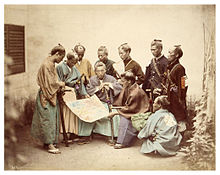 Samurai of the Satsuma clan, during the Boshin War period, circa 1867. Hand-colored Photograph by Felice Beato
Samurai of the Satsuma clan, during the Boshin War period, circa 1867. Hand-colored Photograph by Felice Beato
Emperor Meiji abolished the samurai's right to be the only armed force in favor of a more modern, western-style, conscripted army in 1873. Samurai became Shizoku (士族) who retained some of their salaries, but the right to wear a katana in public was eventually abolished along with the right to execute commoners who paid them disrespect.
The samurai finally came to an end after hundreds of years of enjoyment of their status, their powers, and their ability to shape the government of Japan. However, the rule of the state by the military class was not yet over.
In defining how a modern Japan should be, members of the Meiji government decided to follow the footsteps of the United Kingdom and Germany, basing the country on the concept of "noblesse oblige". Samurai were not to be a political force under the new order.
With the Meiji reforms in the late 19th century, the samurai class was abolished, and a western-style national army was established. The Imperial Japanese Armies were conscripted, but many samurai volunteered to be soldiers and many advanced to be trained as officers. Much of the Imperial Army officer class was of samurai origin and they were highly motivated, disciplined and exceptionally trained.
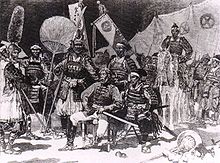 Saigō Takamori (seated, in Western uniform), surrounded by his officers, in samurai attire, during the 1877 Satsuma rebellion. News article in Le Monde Illustré, 1877.
Saigō Takamori (seated, in Western uniform), surrounded by his officers, in samurai attire, during the 1877 Satsuma rebellion. News article in Le Monde Illustré, 1877.
The last samurai conflict was arguably in 1877, during the Satsuma Rebellion in the Battle of Shiroyama. This conflict had its genesis in the previous uprising to defeat the Tokugawa Shogunate, leading to the Meiji Restoration.
The newly formed government instituted radical changes, aimed at reducing the power of the feudal domains, including Satsuma, and the dissolution of samurai status. This led to the ultimately premature uprising, led by Saigō Takamori.
Samurai were many of the early exchange students, not directly because they were samurai, but because many samurai were literate and well-educated scholars. Some of these exchange students started private schools for higher educations, while many samurai took pens instead of guns and became reporters and writers, setting up newspaper companies, and others entered governmental service.
Only the name Shizoku existed after that. After Japan lost World War II, the name Shizoku disappeared under the law on January 1, 1947.
Western samurai
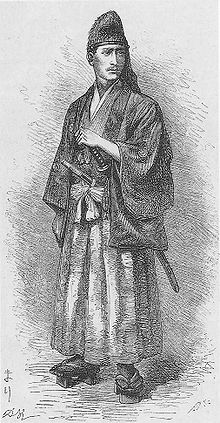 The French Navy officer Eugène Collache fought for the Shogun as a samurai during the Boshin War (1869).
The French Navy officer Eugène Collache fought for the Shogun as a samurai during the Boshin War (1869).
The English sailor and adventurer William Adams (1564–1620) seems to have been the first Caucasian to receive the dignity of samurai. The Shogun Tokugawa Ieyasu presented him with two swords representing the authority of a samurai, and decreed that William Adams the sailor was dead and that Miura Anjin (三浦按針), a samurai, was born. Adams also received the title of hatamoto (bannerman), a high-prestige position as a direct retainer in the Shogun's court. He was provided with generous revenues: "For the services that I have done and do daily, being employed in the Emperor's service, the emperor has given me a living" (Letters). He was granted a fief in Hemi (逸見) within the boundaries of present-day Yokosuka City, "with eighty or ninety husbandmen, that be my slaves or servants" (Letters). His estate was valued at 250 koku (measure of the income of the land in rice equal to about five bushels). He finally wrote "God hath provided for me after my great misery" (Letters) by which he meant the disaster-ridden voyage that had initially brought him to Japan.
Jan Joosten van Lodensteijn (1556?–1623?), a Dutch colleague of Adams' on their ill-fated voyage to Japan in the ship De Liefde, was also given similar privileges by Tokugawa Ieyasu. It appears Joosten became a samurai[citation needed] and was given a residence within Ieyasu's castle at Edo. Today, this area at the east exit of Tokyo Station is known as Yaesu (八重洲). Yaesu is a corruption of the Dutchman's Japanese name, Yayousu (耶楊子). Also in common with Adam's, Joostens was given a Red Seal Ship (朱印船) allowing him to trade between Japan and Indo-China. On a return journey from Batavia Joosten drowned after his ship ran aground.
Also, during the Boshin War (1868–1869), French soldiers joined the forces of the Shogun against the Southern Daimyos favorable to the restoration of the Meiji emperor. It is recorded that the French Navy officer Eugène Collache fought in samurai attire with his Japanese brothers-in-arms. At the same time, the Prussian Edward Schnell served the Aizu domain as a military instructor and procurer of weapons. He was granted the Japanese name Hiramatsu Buhei (平松武兵衛), which inverted the characters of the daimyo's name Matsudaira. Hiramatsu (Schnell) was given the right to wear swords, as well as a residence in the castle town of Wakamatsu, a Japanese wife, and retainers. In many contemporary references, he is portrayed as wearing a Japanese kimono, overcoat, and swords, with Western riding trousers and boots.
Culture
As de facto aristocrats for centuries, samurai developed their own cultures that influenced Japanese culture as a whole. The culture associated with the samurai such as the tea ceremony, monochrome ink painting, rock gardens and poetry were adopted by warrior patrons throughout the centuries 1200–1600. These practices were adapted from the Chinese arts. Zen monks introduced them to Japan and they were allowed to flourish due to the interest of powerful warrior elites. Muso Soseki (1275–1351) was a Zen monk who was advisor to both Emperor Go-Daigo and General Ashikaga Takauji (1304–58). Muso as well as other monks acted as political and cultural diplomats between Japan and China. Muso was particularly well known for his garden design. Another Ashikaga patron of the arts was Yoshimasa. His cultural advisor, the Zen monk Zeami, introduced tea ceremony to him. Previously, tea had been used primarily for Buddhist monks to stay awake during meditation.[27]
Education
In general, samurai, aristocrats, and priests had a very high literacy rate in Kanji. Recent studies have shown that literacy in Kanji among other groups in society was somewhat higher than previously understood. For example, court documents, birth and death records and marriage records from the Kamakura period, submitted by farmers, were prepared in Kanji. Both the Kanji literacy rate and skills in math improved toward the end of Kamakura period.[22]
Literacy was generally high among the warriors and the common classes as well. The feudal lord Asakura Norikage (1474–1555 AD) noted the great loyalty given to his father, due to his polite letters, not just to fellow samurai, but also to the farmers and townspeople:
There were to Lord Eirin's character many high points difficult to measure, but according to the elders the foremost of these was the way he governed the province by his civility. It goes without saying that he acted this way toward those in the samurai class, but he was also polite in writing letters to the farmers and townspeople, and even in addressing these letters he was gracious beyond normal practice. In this way, all were willing to sacrifice their lives for him and become his allies.[28]
In a letter dated January 29, 1552, St Francis Xavier observed the ease of which the Japanese understood prayers due to the high level of literacy in Japan at that time:
There are two kinds of writing in Japan, one used by men and the other by women; and for the most part both men and women, especially of the nobility and the commercial class, have a literary education. The bonzes, or bonzesses, in their monasteries teach letters to the girls and boys, though rich and noble persons entrust the education of their children to private tutors.
Most of them can read, and this is a great help to them for the easy understanding of our usual prayers and the chief points of our holy religion.[29]In a letter to Father Ignatius Loyola at Rome, Xavier further noted the education of the upper classes:
The Nobles send their sons to monasteries to be educated as soon as they are 8 years old, and they remain there until they are 19 or 20, learning reading, writing and religion; as soon as they come out, they marry and apply themselves to politics. They are discreet, magnanimous and lovers of virtue and letters, honouring learned men very much.
In a letter dated November 11, 1549, Xavier described a multi-tiered educational system in Japan consisting of "universities", "colleges", "academies" and hundreds of monasteries which served as a principle center for learning by the populace:
But now we must give you an account of our stay at Cagoxima. We put into that port because the wind was adverse to our sailing to Meaco, which is the largest city in Japan, and most famous as the residence of the King and the Princes. It is said that after four months are passed the favourable season for a voyage to Meaco will return, and then with the good help of God we shall sail thither. The distance from Cagoxima is three hundred leagues. We hear wonderful stories about the size of Meaco : they say that it consists of more than ninety thousand dwellings. There is a very famous University there, as well as five chief colleges of students, and more than two hundred monasteries of bonzes, and of others who are like coenobites, called Legioxi, as well as of women of the same kind, who are called Hamacutis. Besides this of Meaco, there are in Japan five other principal academies, at Coya, at Negu, at Fisso, and at Homia. These are situated round Meaco, with short distances between them, and each is frequented by about three thousand five hundred scholars. Besides these there is the Academy at Bandou, much the largest and most famous in all Japan, and at a great distance from Meaco. Bandou is a large territory, ruled by six minor princes, one of whom is more powerful than the others and is obeyed by them, being himself subject to the King of Japan, who is called the Great King of Meaco. The things that are given out as to the greatness and celebrity of these universities and cities are so wonderful as to make us think of seeing them first with our own eyes and ascertaining the truth, and then when we have discovered and know how things really are, of writing an account of them to you. 10[clarification needed] They say that there are several lesser academies besides those which we have mentioned.
Names
A samurai was usually named by combining one kanji from his father or grandfather and one new kanji. Samurai normally used only a small part of their total name.
For example, the full name of Oda Nobunaga would be "Oda Kazusanosuke Saburo Nobunaga" (織田上総介三郎信長), in which "Oda" is a clan or family name, "Kazusanosuke" is a title of vice-governor of Kazusa province, "Saburo" is a name before genpuku, a coming of age ceremony, and "Nobunaga" is an adult name. Samurai were able to choose their own first names.
Marriage
The marriage of samurai was done by having a marriage arranged by someone with the same or higher rank than those being married. While for those samurai in the upper ranks this was a necessity (as most had few opportunities to meet a female), this was a formality for lower ranked samurai. Most samurai married women from a samurai family, but for a lower ranked samurai, marriages with commoners were permitted. In these marriages a dowry was brought by the woman and was used to start their new lives.
A samurai could have a mistress but her background was strictly checked by higher ranked samurai. In many cases, this was treated like a marriage. "Kidnapping" a mistress, although common in fiction, would have been shameful, if not a crime. When she was a commoner, a messenger would be sent with betrothal money or a note for exemption of tax to ask for her parent's acceptance and many parents gladly accepted. If a samurai's wife gave birth to a son he could be a samurai.
A samurai could divorce his wife for a variety of reasons with approval from a superior, but divorce was, while not entirely nonexistent, a rare event. A reason for divorce would be if she could not produce a son, but then adoption could be arranged as an alternative to divorce. A samurai could divorce for personal reasons, even if he simply did not like his wife, but this was generally avoided as it would embarrass the samurai who had arranged the marriage. A woman could also arrange a divorce, although it would generally take the form of the samurai divorcing her. After a divorce samurai had to return the betrothal money, which often prevented divorces. Some rich merchants had their daughters marry samurai to erase a samurai's debt and advance their positions.
A samurai's wife would be dishonored and allowed to commit jigai (a female's seppuku) if she were cast off.[citation needed]
Philosophy
The philosophies of Buddhism and Zen, and to a lesser extent Confucianism and Shinto, influenced the samurai culture. Zen meditation became an important teaching due to it offering a process to calm one's mind. The Buddhist concept of reincarnation and rebirth led samurai to abandon torture and needless killing, while some samurai even gave up violence altogether and became Buddhist monks after realizing how fruitless their killings were. Some were killed as they came to terms with these realizations in the battlefield. The most defining role that Confucianism played in samurai philosophy was to stress the importance of the lord-retainer relationship; this is, the loyalty that a samurai was required to show his lord.
Bushidō ("way of the warrior") was a term that began to appear in intellectual and nationalist discourse after the Japanese defeat of China in 1885 and of Russia in 1905.[30] Hagakure or "Hidden in Leaves" by Yamamoto Tsunetomo and Gorin no Sho or "Book of the Five Rings" by Miyamoto Musashi both written in the Tokugawa period (1603–1868) are theories often associated with Bushido and Zen philosophy.
The philosophies of Buddhism and Zen, and to a lesser extent Confucianism and Shinto, are attributed to the development of the samurai culture. "The notion that Zen is somehow related to Japanese culture in general, and bushido in particular, is familiar to Western students of Zen through the writings of D. T. Suzuki, no doubt the single most important figure in the spread of Zen in the West." [31]
In an account of Japan sent to Father Ignatius Loyola at Rome, drawn from the statements of Anger (Han-Siro's western name), Xavier describes the importance of honor to the Japanese (Letter preserved at College of Coimbra.):
In the first place, the nation with which we have had to do here surpasses in goodness any of the nations lately discovered. I really think that among barbarous nations there can be none that has more natural goodness than the Japanese. They are of a kindly disposition, not at all given to cheating, wonderfully desirous of honour and rank. Honour with them is placed above everything else. There are a great many poor among them, but poverty is not a disgrace to any one. There is one thing among them of which I hardly know whether it is practised anywhere among Christians. The nobles, however poor they may be, receive the same honour from the rest as if they were rich.[32]
Women
Maintaining the household was the main duty of samurai women. This was especially crucial during early feudal Japan, when warrior husbands were often traveling abroad or engaged in clan battles. The wife, or okugatasama (meaning: one who remains in the home), was left to manage all household affairs, care for the children, and perhaps even defend the home forcibly. For this reason, many women of the samurai class were trained in wielding a polearm called a naginata or a special knife called the kaiken in an art called tantojutsu (lit. the skill of the knife), which they could use to protect their household, family, and honor if the need arose.
Traits valued in women of the samurai class were humility, obedience, self-control, strength, and loyalty. Ideally, a samurai wife would be skilled at managing property, keeping records, dealing with financial matters, educating the children (and perhaps servants, too), and caring for elderly parents or in-laws that may be living under her roof. Confucian law, which helped define personal relationships and the code of ethics of the warrior class required that a woman show subservience to her husband, filial piety to her parents, and care to the children. Too much love and affection was also said to indulge and spoil the youngsters. Thus, a woman was also to exercise discipline.
Though women of wealthier samurai families enjoyed perks of their elevated position in society, such as avoiding the physical labor that those of lower classes often engaged in, they were still viewed as far beneath men. Women were prohibited from engaging in any political affairs and were usually not the heads of their household.
This does not mean that samurai women were always powerless. Powerful women both wisely and unwisely wielded power at various occasions. After Ashikaga Yoshimasa, 8th shogun of the Muromachi shogunate lost interest in politics, his wife Hino Tomiko largely ruled in his place. Nene, wife of Toyotomi Hideyoshi, was known to overrule her husband's decisions at times and Yodo, his mistress, became the de facto master of Osaka castle and the Toyotomi clan after Hideyoshi's death. Chiyo, wife of Yamauchi Kazutoyo, has long been considered the ideal samurai wife. According to legend, she made her kimono out of a quilted patchwork of bits of old cloth and saved pennies to buy her husband a magnificent horse on which he rode to many victories. The fact that Chiyo (though she is better known as "Wife of Yamauchi Kazutoyo") is held to such high esteem for her economic sense is illuminating in the light of the fact that she never produced an heir and the Yamauchi clan was succeeded by Kazutoyo's younger brother. The source of power for women may have been that samurai looked down upon matters concerning money and left their finances to their wives.
As the Tokugawa period progressed more value became placed on education, and the education of females beginning at a young age became important to families and society as a whole. Marriage criteria began to weigh intelligence and education as desirable attributes in a wife, right along with physical attractiveness. Though many of the texts written for women during the Tokugawa period only pertained to how a woman could become a successful wife and household manager, there were those that undertook the challenge of learning to read, and also tackled philosophical and literary classics. Nearly all women of the samurai class were literate by the end of the Tokugawa period.
Weapons
Swords are the weapons that have come to be synonymous with the samurai. Japanese swords from the Nara period swords are called Chokutō and featured a straight blade, by the late 900s curved tachi appeared, followed by the uchigatana and ultimately the katana. Smaller commonly known companion swords are the wakizashi and the tanto.[33] A katana and a Wakizashi or tantō together are called a daishō (literally "big and small"), the wearing of a daisho became the symbol of the samurai as only a samurai was allowed to wear the daisho.
The yumi (longbow), reflected in the art of kyūjutsu (lit. the skill of the bow) was a major weapon of the Japanese military. Its usage declined with the introduction of firearms during the Sengoku period, but the skill was still practiced at least for sport.[34] The yumi, an asymmetric composite bow made from bamboo, wood, rattan and leather, was not as powerful as the Eurasian reflex composite bow, having an effective range of 50 meters (about 164 feet) or 100 meters (328 feet) if accuracy was not an issue. On foot, it was usually used behind a tedate (手盾), a large and mobile bamboo wall, but could also be used from horseback because of its asymmetric shape. The practice of shooting from horseback became a Shinto ceremony known as yabusame (流鏑馬).[35]
Pole weapons including the yari and naginata also became a popular weapon. The yari displaced the naginata from the battlefield as personal bravery became less of a factor and battles became more organized around massed, inexpensive foot troops (ashigaru).[citation needed] A charge, mounted or dismounted, was also more effective when using a spear rather than a sword, as it offered better than even odds against a samurai using a sword. In the Battle of Shizugatake where Shibata Katsuie was defeated by Toyotomi Hideyoshi, then known as Hashiba Hideyoshi, seven samurai who came to be known as the "Seven Spears of Shizugatake" (賤ヶ岳七本槍) played a crucial role in the victory.[36]
Tanegashima a form of matchlock which was introduced to Japan in the 1540s through Portuguese trade, enabling warlords to raise effective armies from masses of peasants. The new weapons were highly controversial. Their ease of use and deadly effectiveness was perceived by many samurai as a dishonorable affront to tradition. Oda Nobunaga made deadly use of the tanegashima at the Battle of Nagashino in 1575, leading to the end of the Takeda clan.[citation needed] Tanegashima were produced on a large scale by Japanese gunsmiths. By the end of the 16th century, there were more firearms in Japan than in any European nation. Tanegashima, employed en masse, largely by ashigaru peasant foot troops, were in many ways the antithesis of samurai valor. With the establishment of the Tokugawa shogunate and an end to civil war, production of tanegashima declined sharply with prohibitions on ownership. By the Tokugawa period most spear-based weapons had been phased out partly because they were suboptimal for the close-quarter combat common at the time; this combined with the aforementioned restrictions on firearms resulted in the daishō being the only weapons typically carried by samurai.[citation needed]
Cannons became a common part of the samurai's armory in the 1570s. They often were mounted in castles or on ships, being used more as anti-personnel weapons than against castle walls or the like, though in the siege of Nagashino castle (1575) a cannon was used to good effect against an enemy siegetower. The first popular cannon in Japan were swivel-breech loaders nicknamed kunikuzushi or "province destroyers". Kunikuzushi weighed 264 lb (120 kg). and used 40 lb (18 kg). chambers, firing a small shot of 10 oz (280 g). The Arima clan of Kyushu used guns like this at the Battle of Okinawate against the Ryūzōji clan. By the time of the Osaka campaign (1614–1615), cannon technology had improved in Japan to the point where at Osaka, Ii Naotaka managed to fire an 18 lb (8.2 kg). shot into the castle's keep.[citation needed]
Staff weapons of many shapes and sizes made from oak and other hard woods were also used by the samurai, commonly known ones include the bō, the jō, the hanbo, and the tanbo.
Clubs and truncheons made of iron and/or wood, of all shapes and sizes were used by the samurai. Some like the jutte were one-handed weapons and others like the kanabo were large two-handed weapons.
Chain weapons, various weapons using chains kusari were used during the samurai era, the kusarigama and Kusari-fundo are examples.
Armor
As far back as the seventh century Japanese warriors wore a form of lamellar armor, this armor eventually evolved into the armor worn by the samurai.[37] The first types of Japanese armors identified as samurai armor were known as yoroi. These early samurai armors were made from small individual scales known as kozane. The kozane were made from either iron or leather and were bound together into small strips, the strips were coated with lacquer to protect the kozane from water. A series of strips of kozane were then laced together with silk or leather lace and formed into a complete chest armor (dou or dō). [37]
In the 1500s a new type of armor started to become popular due to the advent of firearms, new fighting tactics and the need for additional protection. The kozane dou made from individual scales was replaced by plate armor. This new armor which utilized iron plated dou (dō) was referred to as Tosei-gusoku or modern armor.[38][39] Various other components of armor protected the samurai's body. The helmet kabuto was an important part of the samurai's armor. Samurai armor changed and developed as the methods of samurai warfare changed over the centuries.[40] The known last use of samurai armor occurring in 1877 during the satsuma rebellion.[41] As the last samurai rebellion was crushed Japan modernized its defenses and turned to a national conscription army which used uniforms.[42]
The Term samurai originally meant "those who serve in close attendance to nobility", and was written in the Chinese character (or kanji) that had the same meaning. In Japanese, it was originally pronounced in the pre-Heian period as saburau and later as saburai, then samurai in the Edo period. In Japanese literature, there is an early reference to samurai in the Kokinshū (古今集, early 10th century):[43]
Attendant to your nobility
Ask for your master's umbrella
Are thicker than rain
The dews 'neath the trees of MiyaginoThe word bushi (武士, lit. "warrior or armsman") first appears in an early history of Japan called Shoku Nihongi (続日本記, AD 797). In a portion of the book covering the year AD 721, Shoku Nihongi states: "Literary men and Warriors are they whom the nation values". The term bushi is of Chinese origin and adds to the indigenous Japanese words for warrior: tsuwamono and mononofu.
Bushi was the name given to the ancient Japanese soldiers from traditional warrior families. The bushi class was developed mainly in the north of Japan. They formed powerful clans, which in the 12th Century were against the noble families who were grouping themselves to support the imperial family who lived in Kyoto. Samurai was a word used by the Kuge aristocratic class with warriors themselves preferring the word bushi. The term Bushidō, the "way of the warrior," is derived from this term and the mansion of a warrior was called bukeyashiki.
The terms bushi and samurai became synonymous near the end of the 12th century, according to William Scott Wilson in his book Ideals of the Samurai—Writings of Japanese Warriors. Wilson's book thoroughly explores the origins of the word warrior in Japanese history as well as the kanji used to represent the word.
"Breaking down the character bu (武) reveals the radical (止), meaning "to stop," and an abbreviation of the radical (戈 ) "spear." The Shuo Wen, an early Chinese dictionary, gives this definition: "Bu consists of subduing the weapon and therefore stopping the spear." The Tso Chuan, another early Chinese source, goes further:
Bu consists of bun (文), literature or letters (and generally the arts of peace), stopping the spear. Bu prohibits violence and subdues weapons ... it puts the people at peace, and harmonizes the masses.
The radical shi (士) on the other hand seems to have originally meant a person who performs some function or who has the ability in some field. Early in Chinese history it came to define the upper class of society, and in the Book of Han this definition is given :
The shi, the farmer, the craftsman, and the tradesman are the four professions of the people. He who occupies his rank by means of learning is called a shi.
Wilson states that the shi, as the highest of the four classes, brandished the weapons as well as the books. bushi therefore translates as "a man who has the ability to keep the peace, either by literary or military means, but predominantly by the latter".[44]
It was not until the early modern period, namely the Azuchi-Momoyama period and early Edo period of the late 16th and early 17th centuries that the word saburai was replaced with samurai. However, the meaning had changed long before that.
During the era of the rule of the samurai, the term yumitori (弓取, "bowman") was also used as an honorary title of an accomplished warrior even though swordsmanship had become more important. (Japanese archery (kyujutsu) is still strongly associated with the war god Hachiman.)
A samurai with no attachment to a clan or daimyo (大名) was called a ronin (浪人). In Japanese, the word ronin means "wave man", a person destined to wander aimlessly forever, like the waves in the sea. The word came to mean a samurai who was no longer in the service of a lord because his lord had died, because the samurai had been banished or simply because the samurai chose to become a ronin.
The pay of samurai was measured in koku of rice (180 liters; enough to feed a man for one year). Samurai in the service of the han are called hanshi.
The following terms are related to samurai or the samurai tradition:
- Uruwashii
a cultured warrior symbolized by the kanji for "bun" (literary study) and "bu" (military study or arts) - Buke (武家)
A martial house or a member of such a house - Mononofu (もののふ)
An ancient term meaning a warrior. - Musha (武者)
A shortened form of bugeisha (武芸者), lit. martial art man. - Shi (士)
A word roughly meaning "gentleman," it is sometimes used for samurai, in particular in words such as bushi (武士, meaning warrior or samurai). - Tsuwamono (兵)
An old term for a soldier popularized by Matsuo Bashō in his famous haiku. Literally meaning a strong person.
Myth and reality
Most samurai were bound by a code of honor and were expected to set an example for those below them. A notable part of their code is seppuku (切腹 seppuku) or hara kiri, which allowed a disgraced samurai to regain his honor by passing into death, where samurai were still beholden to social rules. Whilst there are many romanticized characterizations of samurai behavior such as the writing of Bushido (武士道 Bushidō) in 1905, studies of Kobudo and traditional Budō indicate that the samurai were as practical on the battlefield as were any other warrior.
Despite the rampant romanticism of the 20th century, samurai could be disloyal and treacherous (e.g., Akechi Mitsuhide), cowardly, brave, or overly loyal (e.g., Kusunoki Masashige). Samurai were usually loyal to their immediate superiors, who in turn allied themselves with higher lords. These loyalties to the higher lords often shifted; for example, the high lords allied under Toyotomi Hideyoshi (豊臣秀吉) were served by loyal samurai, but the feudal lords under them could shift their support to Tokugawa, taking their samurai with them. There were, however, also notable instances where samurai would be disloyal to their lord or daimyo, when loyalty to the emperor was seen to have supremacy.[45]
In popular culture
Jidaigeki (lit. historical drama) has always been a staple program on Japanese movies and TV. The programs typically feature a samurai. Samurai films and westerns share a number of similarities and the two have influenced each other over the years. Kurosawa was inspired by the works of director John Ford and in turn Kurosawa's works have been remade into westerns such as The Seven Samurai into The Magnificent Seven and Yojimbo into A Fistful of Dollars. There is also an anime adaptation (Samurai 7) of "The Seven Samurai" which spans 26 episodes. Eiji Yoshikawa is one of the most famous Japanese historical novelists. His retellings of popular works, including Taiko, Musashi and Heike Tale are popular among readers for their epic narratives and rich realism in depicting samurai and warrior culture.
The samurai have also appeared frequently in Japanese comics (manga) and animation (anime). Most common are historical works where the protagonist is either a samurai or former samurai (or another rank/position) who possesses considerable martial skill. Samurai-like characters are not just restricted to historical settings and a number of works set in the modern age, and even the future, include characters who live, train and fight like samurai. American comic books have adopted the character type for stories of their own.
Hollywood released in 2003 a movie titled, "The Last Samurai", starring Tom Cruise, inspired by the Samurai way of life.
Famous samurai
See also
References
- ^ Wilson, p. 17
- ^ "Samurai (Japanese warrior)". Encyclopædia Britannica.
- ^ a b William Wayne Farris, Heavenly Warriors — The Evolution of Japan's Military, 500–1300, Harvard University Press, 1995. ISBN 067438704X
- ^ A History of Japan, Vol. 3 and 4, George Samson, Tuttle Publishing, 2000.
- ^ Cleary, Thomas Training the Samurai Mind: A Bushido Sourcebook Shambhala (May, 2008) ISBN 1-59030-572-8
- ^ Wilson, p. 38
- ^ Carl Steenstrup, PhD Thesis, University of Copenhagen (1979)
- ^ Wilson, p. 47
- ^ Wilson, p. 62
- ^ Wilson, p. 103
- ^ Wilson, p. 95
- ^ Wilson, p. 67
- ^ Wilson, p, 131
- ^ Stacey B. Day; Kiyoshi Inokuchi; Hagakure Kenkyūkai (1994). The wisdom of Hagakure: way of the Samurai of Saga domain. Hagakure Society. p. 61. http://books.google.com/books?id=QYsQAQAAIAAJ. Retrieved 9 April 2011.
- ^ Brooke Noel Moore; Kenneth Bruder (6 August 2001). Philosophy: the power of ideas. McGraw-Hill. p. 494. ISBN 9780767420112. http://books.google.com/books?id=3kcIWXk8UhMC. Retrieved 9 April 2011.
- ^ Wilson, p. 122
- ^ Wilson, p. 91
- ^ Daisetz Teitarō Suzuki (1938). Zen and Japanese culture. Princeton University Press. ISBN 9780691017709. http://books.google.com/books?id=j8c9AAAAIAAJ. Retrieved 9 April 2011.
- ^ Daisetz Teitarō Suzuki (1938). Zen and Japanese culture. Princeton University Press. pp. 78–. ISBN 9780691017709. http://books.google.com/books?id=j8c9AAAAIAAJ&pg=PA78. Retrieved 9 April 2011.
- ^ H. Paul Varley (2000). Japanese culture. University of Hawaii Press. pp. 143–. ISBN 9780824821524. http://books.google.com/books?id=BvUEzBin61AC&pg=PA143. Retrieved 9 April 2011.
- ^ Coleridge, p. 100
- ^ a b Matsura, Yoshinori Fukuiken-shi 2 (Tokyo: Sanshusha, 1921)
- ^ Philip J. Adler; Randall L. Pouwels (27 November 2007). World Civilizations: Since 1500. Cengage Learning. pp. 369–. ISBN 9780495502623. http://books.google.com/books?id=mPoqfoiIp4sC&pg=PA369. Retrieved 9 April 2011.
- ^ a b Wilson, p. 26
- ^ Wilson
- ^ Wilson , p. 15
- ^ R. H. P. Mason; John Godwin Caiger (15 November 1997). A history of Japan. Tuttle Publishing. pp. 152–. ISBN 9780804820974. http://books.google.com/books?id=m_XL2iELo-oC&pg=PA152. Retrieved 9 April 2011.
- ^ Wilson, p. 85
- ^ Coleridge, p. 345
- ^ Sharf, Robert H "The Zen of Japanese Nationalism" (University of Chicago Press, 1993)
- ^ Sharf, Robert H. "The Zen of Japanese Nationalism" (University of Chicago Press, 1993) p. 12
- ^ Coleridge, p. 237
- ^ Karl F. Friday (2004). Samurai, warfare and the state in early medieval Japan. Psychology Press. pp. 78–80. ISBN 978-0-415-32963-7. http://books.google.com/books?id=q5KBjpGSRgkC&pg=PA78. Retrieved 5 November 2011.
- ^ Kathleen Haywood; Catherine Lewis (2006). Archery: steps to success. Human Kinetics. pp. 10–. ISBN 9780736055420. http://books.google.com/books?id=-EFySHOgGmIC&pg=PR10. Retrieved 9 April 2011.
- ^ Thomas Louis; Tommy Ito (5 August 2008). Samurai: The Code of the Warrior. Sterling Publishing Company, Inc.. pp. 117–. ISBN 9781402763120. http://books.google.com/books?id=wExlaM1ov0sC&pg=PA117. Retrieved 9 April 2011.
- ^ Stephen Turnbull (11 April 2008). The Samurai Swordsman: Master of War. Tuttle Publishing. pp. 65–. ISBN 9784805309568. http://books.google.com/books?id=NR9j09T2hLkC&pg=PA65. Retrieved 9 April 2011.
- ^ a b Stephen R. Turnbull (1996). The Samurai: a military history. Psychology Press. pp. 20–. ISBN 9781873410387. http://books.google.com/books?id=RMBdoimD2kIC&pg=PA20. Retrieved 9 April 2011.
- ^ Clive Sinclaire (1 November 2004). Samurai: The Weapons and Spirit of the Japanese Warrior. Globe Pequot. pp. 32–. ISBN 978-1-59228-720-8. http://books.google.com/books?id=IQ3FAZG94ZsC&pg=PA32. Retrieved 5 November 2011.
- ^ {{cite book|author=William E. Deal |title=Handbook to life in medieval and early modern Japan |url=http://books.google.com/books?id=i0ni1NmbYe0C&pg=PA171 |accessdate=5 November 2011 |date=12 September 2007 |publisher=Oxford University Press |isbn=978-0-19-533126-4 |pages=171–}
- ^ Oscar Ratti; Adele Westbrook (1991). Secrets of the samurai: a survey of the martial arts of feudal Japan. Tuttle Publishing. pp. 186–. ISBN 9780804816847. http://books.google.com/books?id=ZFf9e0DmHZUC&pg=PA186. Retrieved 9 April 2011.
- ^ Clive Sinclaire (1 November 2004). Samurai: The Weapons and Spirit of the Japanese Warrior. Globe Pequot. pp. 58–. ISBN 978-1-59228-720-8. http://books.google.com/books?id=IQ3FAZG94ZsC&pg=PA58. Retrieved 5 November 2011.
- ^ The connoisseur's book of Japanese swords, Kōkan Nagayama, Kodansha International, 1998 p.43
- ^ Kokin wakashu (Japanese)
- ^ Wilson, p. 16
- ^ Mark Ravina, The Last Samurai — The Life and Battles of Saigō Takamori, John Wiley & Sons, 2004.
Bibliography
- Coleridge, Henry James. the Life and Letters of St. Francis Xavier. Forgotten Books. ISBN 9781451000481. http://books.google.com/books?id=o6n9jLF4IwUC. Retrieved 9 April 2011.
- Wilson, William Scott (1982). Ideals of the Samurai: Writings of Japanese Warriors. Kodansha. ISBN 0-89750-081-4. http://books.google.com/books?id=zAl8YHtqXxgC&printsec=frontcover.
External links
- The Samurai Archives Japanese History page
- Samurai Swords and Samurai Culture
- History of the Samurai
Categories:- Samurai
- Japanese warriors
- Japanese words and phrases
- Combat occupations
- Uruwashii
Wikimedia Foundation. 2010.

